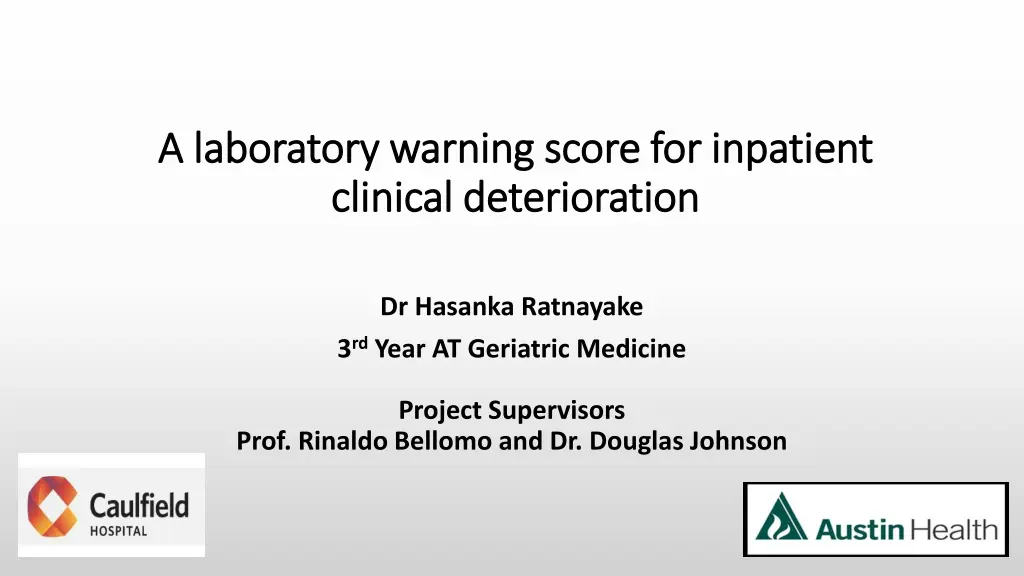
Laboratory Warning Score for Inpatient Clinical Deterioration Study
This study conducted by Dr. Hasanka Ratnayake aims to assess the effectiveness of a laboratory-based admission score in predicting in-hospital mortality, ICU admission, Medical Emergency Team activation, and Cardiopulmonary arrest in Australian general medical patients, with a specific focus on those over 75 years of age. The retrospective observational study analyzed various laboratory data and calculated the area under the receiver operating characteristic curve for different outcomes of interest. Results from 3515 admissions showed key baseline patient characteristics and events like death, ICU admission, MET calls, and Code Blue occurrences.
Download Presentation

Please find below an Image/Link to download the presentation.
The content on the website is provided AS IS for your information and personal use only. It may not be sold, licensed, or shared on other websites without obtaining consent from the author. If you encounter any issues during the download, it is possible that the publisher has removed the file from their server.
You are allowed to download the files provided on this website for personal or commercial use, subject to the condition that they are used lawfully. All files are the property of their respective owners.
The content on the website is provided AS IS for your information and personal use only. It may not be sold, licensed, or shared on other websites without obtaining consent from the author.
E N D
Presentation Transcript
A laboratory warning score for inpatient A laboratory warning score for inpatient clinical deterioration clinical deterioration Dr Hasanka Ratnayake 3rdYear AT Geriatric Medicine Project Supervisors Prof. Rinaldo Bellomo and Dr. Douglas Johnson
Background Background Predicting clinical deterioration allows timely interventions to: Prevent harm Discuss goals of care Current Practice Vital bedside observations measured Future Practice Could pathology results be used to predict clinical deterioration?
Aim Aim 1. To assess whether a simple laboratory-based admission score can predict: In-hospital mortality ICU admission Medical Emergency Team (MET) activation or Cardiopulmonary arrest in a cohort of Australian general medical patients >18 years of age 2. Does this score perform equally well in people over 75 years of age?
Methods Methods Retrospective observational study of all General Medical admissions in 2015 Exposure Outcome In-hospital mortality ICU admission Medical Emergency Team (MET) activation or Cardiopulmonary arrest Laboratory data decision tree Early Warning Score (LDT-EWS) Haemaglobin White Cell Count Urea Creatinine Sodium Potassium Albumin Score 3 2 1 0 1 2 3 Hb <11.1 11.2-12.8 >12.9 WCC 9.3 9.4-16.6 16.7
Statistical Analysis Statistical Analysis Simple summary statistics to describe sample Calculated the area under the receiver operating characteristic curve (AUC ROC) for each outcomes of interest In-hospital mortality ICU admission Medical Emergency Team (MET) activation Cardiopulmonary arrest Repeated the AUC calculations in those >75 years
Results Results 3515 admissions Baseline Patient Characteristics Mean (sd) n/N (%) 77.50 15.04 Average Age (years) Percentage female (%) 52 16 % required data from previous 3 months to generate score Median LDT-EWS: 4 (IQR 2-6) Death ICU Admission MET Call Code Blue Number of events (%) 165 (4.7%) 91 (2.6%) 325 (9.2%) 15 (0.4%)
Results Results Death Death Death (All ages) Death (Age >75) 1.00 1.00 0.75 0.75 Sensitivity Sensitivity 0.50 0.50 AUC 0.74 AUC 0.72 0.25 0.25 0.00 0.00 0.00 0.25 0.50 0.75 1.00 0.00 0.25 0.50 0.75 1.00 1 - Specificity 1 - Specificity Area under ROC curve = 0.7447 Area under ROC curve = 0.7213
Results Results Cardiopulmonary Arrest Cardiopulmonary Arrest Cardiopulmonary arrest (All ages) Cardiopulmonary arrest (Age >75) 1.00 1.00 0.75 0.75 Sensitivity Sensitivity 0.50 0.50 AUC 0.87 AUC 0.80 0.25 0.25 0.00 0.00 0.00 0.25 0.50 0.75 1.00 0.00 0.25 0.50 0.75 1.00 1 - Specificity 1 - Specificity Area under ROC curve = 0.8040 Area under ROC curve = 0.8687 AUC ICU admission: 0.63; AUC MET call: 0.59
Discussion Discussion The Laboratory data decision tree Early Warning Score (LDT-EWS) has fair to good predictive ability for death and cardiopulmonary arrest but not for MET call or ICU admission Similar results in those > 75 years of age Help identify patients at risk early using routine pathology Adjunct to clinical judgement and vital signs
Strengths and Limitations Strengths and Limitations Strengths Large number of patients Objective exposure and outcome measures First to utilize this risk score in an Australian cohort First to extend this score to analyze outcomes other than death First to analyze score in patients aged >75years Limitations Single centre Imputed scores (albumin)
Recommendations Recommendations Further studies to develop cut-points for scoring Additional analyses in other age groups Consider including clinical observations of deterioration risk
